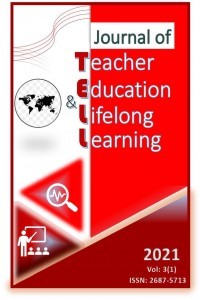GENOGRAM: EXAMINATION of THREE GENERATIONS of CEVDET BEY ve OĞULLARI
Cevdet Bey ve Oğulları, Genogram, Orhan Pamuk
GENOGRAM: EXAMINATION of THREE GENERATIONS of CEVDET BEY ve OĞULLARI
Cevdet Bey ve Oğulları, Genogram, Orhan Pamuk,
___
- Ak, M., Kesici, Ş. Yalçın, B. S. & Kavaklı, M. (2019). Çocuğum bağımlı olmasın. Nobel Yayınları.
- Arkar, H. & Şafak, C. (2003). Farkındalığı arttırmada genogram kullanımı. Türk Psikoloji Yazıları, 6(11), 21-31.
- Atlı, F. (2012). Edebi metnin ve yaratıcılığın kaynağına ulaşan yol: Psikanalitik edebiyat eleştirisi. Electronic Turkish Studies, 7(3), 257-273.
- Carlson, J., Sperry, L. & Lewis, J. A. (2005). Family therapy technniques integrating and tailoring treatment. Routledge.
- Cook, J. M. & Poulsen, S. S. (2011). Utilizing photographs with the genogram: a technique for enhancing couple therapy. Journal of Systemic Therapies, 30(1), 14-23. https://doi.org/10.1521/jsyt.2011.30.1.14
- Çıkıt, B. (2017). Evli bireylerde bağlanma stilleri ve aldatma eğiliminin şema terapi modeli çerçevesinde değerlendirilmesi. Haliç Üniversitesi Sosyal Bilimler Enstitüsü Yayınlanmamış Yüksek Lisans Tezi, İstanbul.
- Dunn, A. B. & Levitt, M. M. (2000). The genogram: From diagnostics to mutual collaboration. Counseling and Therapy for Couples and Families, 8(3), 235-244.
- Friedman, H. & Krakauer, S. (1992). Learning to draw and interpret standard and timeline genograms: an experimental comparison. Journal of Family Psychology, 6(1), 77-83. https://doi.org/10.1037/0893-3200.6.1.77
- Foster, M. A., Jurkovic, G. J., Ferdinand, L. G. & Meadows, L. A. (2002). The impact of the genogram on couples: a manualized approach. The Family Journa,l 10(34), 34-40. https://doi.org/10.1177/1066480702101006
- Gladding, T. S. (2014). Family therapy history, therapy, and practise. Pearson.
- Goldenberg, H. & Goldenberg, I. (2007). Family therapy: An overview. Brooks Cole.
- Guerin, P. J. & Pendagast, E. G. (1976). Evaluation of family system and genogram. Family therapy: Theory and practice, 450-464.
- Hendrick, S. S. (2016). Yakın ilişkiler psikolojisi. (A. Dönmez, A. Büyükşahin Suna, Çev.). Nobel.
- Işık, E. (2008). Soy ağacı tekniğinin aile ve kariyer psikolojik danışmanlığında kullanılması. Dokuz Eylül Üniversitesi Buca Eğitim Fakültesi Dergisi, 23, 87-97.
- Işık, E., Akbaş, T., Kırdök, O., Avcı, R. & Çakır, İ. (2012). Use of the genogram technique in counseling with Turkish families. Journal of Family Psychotherapy, 23(2), 131-137. https://doi.org/10.1080/08975353.2012.679903
- Jolly, W., Froom, J., & Rosen, M. G. (1980). The genogram. J Fam Pract, 10(2), 251-5.
- Kesici, Ş., (Edt.). (2015). Vaka örnekleriyle birlikte aile danışma kuramları ve teknikleri. Nobel Yayınları
- Kesici, Ş., Mert, A., Girgin Büyükbayraktar, Ç. & İlgün, E. (2015). Aile terapisinde kullanılan teknikler. Nobel Yayınları.
- Kosutic, I., Garcia, M., Graves, T., Barnett, F., Hall, J. Haley, E., Rock, J., Bathon, A. & Kaiser, B. (2009). The critical genogram: a tool for promoting critical consciousness. Journal of Feminist Family Therapy, 21, 151-176. https://doi.org/10.1080/08952830903079037
- Marchetti-Mercer, M. & Cleaver, G. (2000). Genograms and family sculpting: an aid to cross-cultural understanding in the training of psychology students in South Africa. The Counseling Psychologist, 28(1), 61-80. https://doi.org/10.1177/0011000000281004
- McGoldrick, M., Gerson, R. & Shellenberger, S. (1999). Genogram: assesment and intervention. Norton & Company.
- McGoldrick, M., Gerson, R. & Petry, S. (2008). Genograms: Assessment and intervention. W W Norton & Company.
- McGoldrick, M. (2016). The Genogram Casebook: A Clinical Companion to Genograms: Assessment and Intervention. W W Norton & Company.
- Mitrofan, I. & Petre, L. (2012). Art-genogram effects on dyadic relationship dynamic as a unifying transgenerational psychotherapy technique. Procedia-Social and Behavioral Sciences, 78, 255- 259. https://doi.org/10.1016/j.sbspro.2013.04.290
- Norment, L. (1998). Infidelity II Why women cheat. Ebony.
- Pamuk, O. (2002). Cevdet Bey ve oğulları. İletişim Yayınları.
- Papadopoulos, L., Bor, R. & Stanion, P. (1997) Genograms in counselling practise: A review. Counselling Psychology Quarterly, 10(1), 17-29. https://doi.org/10.1080/09515079708251408
- Peluso, P.R. (2003). The ethical genogram: a tool for helping therapists understand their ethical decisions-making styles. Family Journal: Counseling and Therapy for Couples and Families, 11(3), 286-91. http://dx.doi.org/10.1177/1066480703011003009
- Roberto, L. G. (1992). Transgenerational family therapies. Guilford Press.
- Sargın, N. (2013). Üniversite öğrencilerinin internete yönelik tutumları ve problemli internet kullanımları. Turkish Journal of Education, 2(2), 44-53. https://doi.org/10.19128/turje.181059
- Sargın, N. Yaşlılık psikolojisine örnek: Abbas Sayar’ın Can Şenliği Romanı. Eğitim ve Öğretim Araştırmaları Dergisi, 6(3), 243-251.
- Stanion, P., & Papadopoulos, L. (1997). Genograms in counselling practice: constructing a genogram. Counselling Psychology Quarterly, 10(2), 139-149. https://doi.org/10.1080/09515079708254167
- Taşdelen, V. (2015) Edebiyat ve psikoloji. Bizim Külliye, (66), 1-6.
- Tessina, T. (2003). It ends with you: Grow up and out of dysfunction. New Page Books.
- Tessina, T. (2002). How to be a couple and still be free. Career Press.
- Yalçıni S. B., Çarkıt, E. & Koçakoğlu, M. G. (2022). The mediating role of resilience between career adaptability and life satisfaction. Journal of Teacher Education and Lifelong Learning, 4(2), 99-109.
- Wachtel, E. F. (1982). The family psyche over three generations:The genogram revisited. Journal of Marital and Family Therapy, 8(3), 335–343. https://doi.org/10.1111/j.17520606.1982.tb01456.x
- Weil, M.W. (1975), Extramarital Reltaionships: A Reappraisal, Journal of Clinical Psychology, 31 (4), 723 – 725. https://doi.org/10.1002/1097-4679(197510)31:4<723::AID-JCLP2270310437>3.0.CO;2-3
- Yznaga, S. (2008). Using the genogram to facilitate the intercultural competence of Mexican immigrants. Family Journal: Counseling and Therapy for Couples and Families, 16(2), 159-165. https://doi.org/10.1177/1066480707313801
- ISSN: 2687-5713
- Başlangıç: 2019
- Yayıncı: Ertuğrul USTA
Metaphors Developed by Teachers for the Gamification Approach in Education
Niyazi AKSOY, Elif AKSOY, Ertugrul USTA
Using Big Data in Education: Curriculum Review with Educational Data Mining
Yusuf Ziya OLPAK, Mustafa YAĞCI
Examining the past of distance education and the views of faculty members on the present and future
Yunus ÖZDEMİR, Erkan TEKİNARSLAN
Investigation of the Opinions of Drama Leaders on Drama Education and Activities
Muhammet Emre KILIÇ, Burak ASLAN
Ümit YEL, Bahadır KILCAN, Sadettin ERBAŞ, Zeynep YAYLACI KILIÇ, Tuğba KILCAN, Tevfik PALAZ
Nesibe GÜNAY MOLU, Mahsum KORKUTAN, Burcu CEYLAN, Tuba KORKMAZ ASLAN
Special Education Students’ Attitudes towards Assistive Technologies
